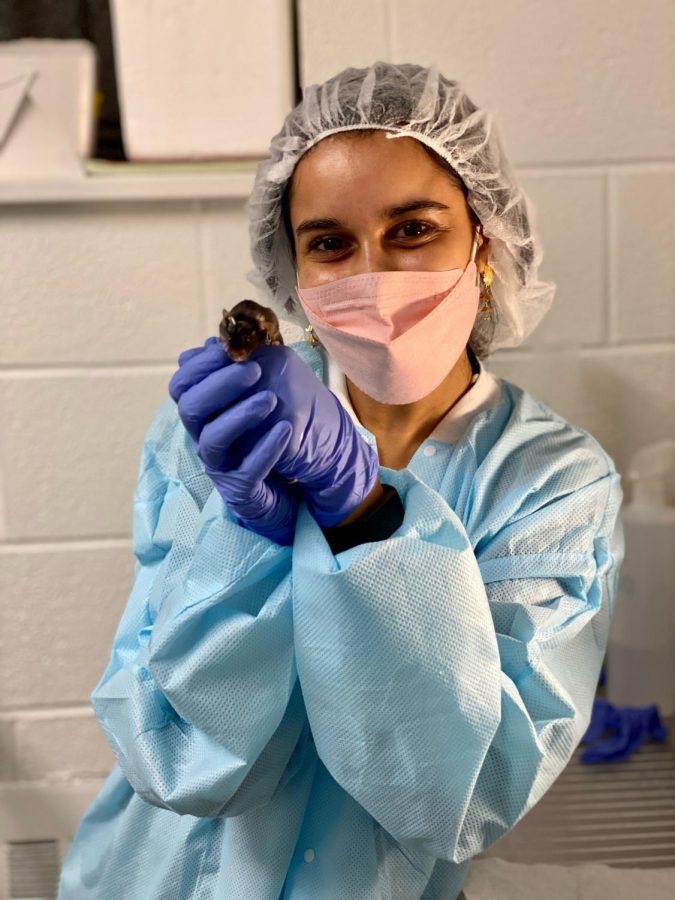Fordham Senior Researches What Drives Our Brains and Our Responses
For the past two years, Ruby Setara, FCRH ’23, has been working in Dr. Eduardo Gallo’s Neurobiology of Motivated Behavior Lab, studying the specifics of what inside our brains drives our responses and behaviors. In particular, Setara, who is studying biological sciences, is looking at a specific type of neuron, called the ventral pallidum cholinergic projection neuron (VP-CPNs).
According to Setara, understanding the underlying brain mechanisms that drive humans is key to learning more about certain brain disorders like ADHD, depression and substance abuse disorders, because they all have motivational impairment. “When we understand this, we can understand how to treat them.”
The VP-CPNs that Setara studies are located in the ventral pallidum region of the brain, which works by projecting neurons into other parts of the brain that are known to be associated with cue processing and driving motivated behavior. However, Setara said that these VP-CPNs are not commonly studied in research today, so their role in motivating behavior has not been explored completely.
Previously, Setara received two summer undergraduate research grants to study these VP-CPNs. After her previous research on this topic, she came to conclusions that ultimately led her to have more questions than answers about the role of these neurons in driving motivated behavior. Setara found that VP-CPNs were not required in cue-linked behavior, nor were they required for cue-mediated reinstatement of behavior. This led her to her most recent study that she has been conducting this semester with the Len Blavatnik Research Fellowship. Currently, Setara is working with a cohort of mice that have an optic fiber implanted in their brains to investigate how VP-CPNs act in response to cues, cue-seeking behavior or to the reward itself. “We can use that connection from the mouse with fiber photometry equipment to visualize those neurons as the mouse is literally doing the behavior task, which is super helpful, because you can see… in real-time,” said Setara.
Setara ran the mice on a task of receiving a reward when they pressed a lever. The goal of this was to see if VP-CPNs were required in reward-predicting stimuli, is a light cue, reward-seeking behavior. When the mice pressed the level, they received milk as a reward. Setara analyzed these signals while the mice were doing the task, and then changed up some of the conditions of the experiment, for instance, pre-feeding the mice with their reward prior to completing the task, which would devalue the reward, or watering down the milk to make the reward less palatable for the mice.
Setara finished running the experiments for this portion of the lab and is currently analyzing the data that she collected. “I’m doing a lot of sorting [for] each trial of the behavior task… so it’s a lot of data parsing and a lot of comparing across mice and combining cohorts just to get a concrete answer to my question,” said Setara.
Thus far in her data analysis, Setara has been able to preliminarily see that VP-CPNs fire more robustly in response to reward-seeking behavior, which is when the mouse presses the lever, and for the reward itself, but not as much for the cue, which is when the light turns on. “This kind of supports what I found in my summer 2022 project, where I saw that… these neurons weren’t required in a cue-linked task, so my data kind of supports that there’s negligible activity at the cue, but on… cue-seeking and the reward itself, there’s a lot more activity,” said Setara.
Setara said she hopes to complete her data parsing by the FCRH Undergraduate Research Symposium so that she can share some of her preliminary results and findings. She also said she wants to get her research published in a neuroscience journal. In the future, Setara said she wants to have a career in research, and working as a part of this lab has allowed her to foster a love for neuroscience that goes beyond the classroom. She said she has accepted a job to work as a researcher at Mt. Sinai studying a rare brain tumor, which will allow her to continue her work in neuroscience research but delve into a different topic.
Speaking more broadly, Setara said she hopes that her research will lead to a greater understanding of the processes inside the brain regarding motivated behavior. “The more we understand what goes on inside, the more we can target certain behaviors and whatnot, whether it be through drug therapies that target specific neurons or even behavior therapies that can target motivational disfunction; I feel like the research has a lot of potential for finding out what even drives these processes in the first place because we don’t even know, and when we don’t know what causes this, it gets even harder to treat it,” said Setara.















































































































































































































